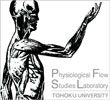

Description
Biological flows is an interdisciplinary
subject that demands an interactive cooperation of several research fields
such as biotechnology, engineering, medicine, chemistry, informatics and
optics. Over the years, flow visualization techniques based on image processing
and analysis have been applied in an effort to make the invisible visible
with the help of experimental and computational technology. Hence, flow
visualization techniques have become an indispensable tool to understand
the flow behavior of several kinds of biological fluids (e.g. DNA solutions,
blood and other physiological fluids) in living systems and biomedical
devices. Doppler ultrasound and magnetic resonance imaging (MRI) are the
most commonly used medical instruments to investigate physiological flow
both in vivo and in vitro. However, due to their poor spatial resolution,
it is difficult to obtain quantitative flow information. In recent years,
as a result of advances in computers, optics, fluorescent probes and image
analysis, several new visualization techniques have been developed in
an effort to overcome such limitations. One example of success is the
micro-scale particle image velocimetry (PIV) technique, which can be used
to quantify the velocity field of biological flows. This thematic session
will provide an opportunity to the bioengineering and biomedical community
to exchange knowledge and information on the latest advances and challenges
in visualization technologies and its application to biological flow research
and industry. We hope to bring together researchers who are interested
in the general field of flow visualization, especially in its applications
to biomedical areas.













